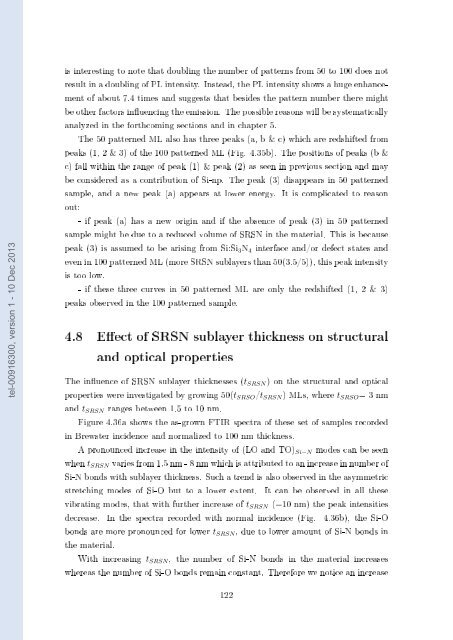Films minces à base de Si nanostructuré pour des cellules ...
Films minces à base de Si nanostructuré pour des cellules ...
Films minces à base de Si nanostructuré pour des cellules ...
Create successful ePaper yourself
Turn your PDF publications into a flip-book with our unique Google optimized e-Paper software.
tel-00916300, version 1 - 10 Dec 2013<br />
is interesting to note that doubling the number of patterns from 50 to 100 does not<br />
result in a doubling of PL intensity. Instead, the PL intensity shows a huge enhancement<br />
of about 7.4 times and suggests that besi<strong>de</strong>s the pattern number there might<br />
be other factors inuencing the emission. The possible reasons will be systematically<br />
analyzed in the forthcoming sections and in chapter 5.<br />
The 50 patterned ML also has three peaks (a, b & c) which are redshifted from<br />
peaks (1, 2 & 3) of the 100 patterned ML (Fig. 4.35b). The positions of peaks (b &<br />
c) fall within the range of peak (1) & peak (2) as seen in previous section and may<br />
be consi<strong>de</strong>red as a contribution of <strong>Si</strong>-np. The peak (3) disappears in 50 patterned<br />
sample, and a new peak (a) appears at lower energy. It is complicated to reason<br />
out:<br />
- if peak (a) has a new origin and if the absence of peak (3) in 50 patterned<br />
sample might be due to a reduced volume of SRSN in the material. This is because<br />
peak (3) is assumed to be arising from <strong>Si</strong>:<strong>Si</strong> 3 N 4 interface and/or <strong>de</strong>fect states and<br />
even in 100 patterned ML (more SRSN sublayers than 50(3.5/5)), this peak intensity<br />
is too low.<br />
- if these three curves in 50 patterned ML are only the redshifted (1, 2 & 3)<br />
peaks observed in the 100 patterned sample.<br />
4.8 Eect of SRSN sublayer thickness on structural<br />
and optical properties<br />
The inuence of SRSN sublayer thicknesses (t SRSN ) on the structural and optical<br />
properties were investigated by growing 50(t SRSO /t SRSN ) MLs, where t SRSO = 3 nm<br />
and t SRSN ranges between 1.5 to 10 nm.<br />
Figure 4.36a shows the as-grown FTIR spectra of these set of samples recor<strong>de</strong>d<br />
in Brewster inci<strong>de</strong>nce and normalized to 100 nm thickness.<br />
A pronounced increase in the intensity of (LO and TO) <strong>Si</strong>−N mo<strong>de</strong>s can be seen<br />
when t SRSN varies from 1.5 nm - 8 nm which is attributed to an increase in number of<br />
<strong>Si</strong>-N bonds with sublayer thickness. Such a trend is also observed in the asymmetric<br />
stretching mo<strong>de</strong>s of <strong>Si</strong>-O but to a lower extent. It can be observed in all these<br />
vibrating mo<strong>de</strong>s, that with further increase of t SRSN (=10 nm) the peak intensities<br />
<strong>de</strong>crease. In the spectra recor<strong>de</strong>d with normal inci<strong>de</strong>nce (Fig. 4.36b), the <strong>Si</strong>-O<br />
bonds are more pronounced for lower t SRSN , due to lower amount of <strong>Si</strong>-N bonds in<br />
the material.<br />
With increasing t SRSN , the number of <strong>Si</strong>-N bonds in the material increases<br />
whereas the number of <strong>Si</strong>-O bonds remain constant. Therefore we notice an increase<br />
122
















